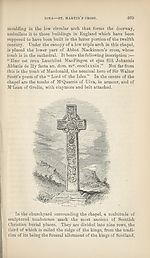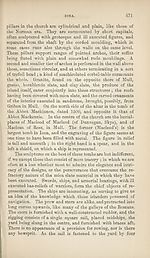Download files
Complete book:
Individual page:
Thumbnail gallery: Grid view | List view

470
ARGYLESHIKE, ETC.
Ireland, and Norway. The fourth row contains an elegant
monument of the four priors of Iona, bearing date 1500. At
the end of the sixth row, near the chapel, is a stone basin, in
which it is said pilgrims performed the superstitious rite of
turning thrice round a number of stones placed in the cavity.
This was called clacha-brath, from two Gaelic words signifying
world and stone, and it was designed to typify the gradual dis¬
solution of the world. The seventh row contains the tombs in
high relief, of the MacLeans of Duart, Loch Buy, and Coll,
whose warlike figures are represented in full armour, and a
stag hunt is represented on one of the stones in the eighth row.
The most of these stones were restored to light by the exer¬
tions of the members of the Iona Club, and a number of them
are accurately engraved in the “ Antiquities of Iona, by H. D.
Graham.”
On entering the enclosure of the cathedral is St. Martin’s
Cross, another of those memorials of a somewhat perplexing
nature that are to be found scattered throughout the provinces
of Scotland and Ireland. A rough sketch of this is given in
the accompanying woodcut. It is sixteen feet high, and is cut
out of a solid block of mica schist.
The Cathedral, or St. Mary’s Church, belongs probably to
the early part of the thirteenth century, if it be even of an
antiquity so high. The oldest pointed form or early English
prevails, while the circular pillars and their decorations are
the vestiges of the previous type. It is cruciform but without
aisles, with a square tower at the intersection, and the struc¬
ture, which probably never was highly elaborated, has been so
battered and repaired that if we except some curious capitals
and the tracery of the windows in the tower, not much is left
to requite the pilgrimage of the mere architectural antiquarian.
The length from east to west is about 160 feet, and that of the
transept about 70. The tower is about 70 feet in height.
This is lighted on two sides ; on one by a window, consisting
of a plain slab, perforated with quatrefoils ; on the other, by a
circular light, with spirally-curved mullions, one of the
varieties of the Catherine wheel window.* The shafts of the
* The shaft in the plain slab window is in a totally different style from the
tracery with which it is connected, and may be a relic of the earlier fane which
witnessed the interment of the Pictish and Scottish monarchs.—Billing's baronial
ARGYLESHIKE, ETC.
Ireland, and Norway. The fourth row contains an elegant
monument of the four priors of Iona, bearing date 1500. At
the end of the sixth row, near the chapel, is a stone basin, in
which it is said pilgrims performed the superstitious rite of
turning thrice round a number of stones placed in the cavity.
This was called clacha-brath, from two Gaelic words signifying
world and stone, and it was designed to typify the gradual dis¬
solution of the world. The seventh row contains the tombs in
high relief, of the MacLeans of Duart, Loch Buy, and Coll,
whose warlike figures are represented in full armour, and a
stag hunt is represented on one of the stones in the eighth row.
The most of these stones were restored to light by the exer¬
tions of the members of the Iona Club, and a number of them
are accurately engraved in the “ Antiquities of Iona, by H. D.
Graham.”
On entering the enclosure of the cathedral is St. Martin’s
Cross, another of those memorials of a somewhat perplexing
nature that are to be found scattered throughout the provinces
of Scotland and Ireland. A rough sketch of this is given in
the accompanying woodcut. It is sixteen feet high, and is cut
out of a solid block of mica schist.
The Cathedral, or St. Mary’s Church, belongs probably to
the early part of the thirteenth century, if it be even of an
antiquity so high. The oldest pointed form or early English
prevails, while the circular pillars and their decorations are
the vestiges of the previous type. It is cruciform but without
aisles, with a square tower at the intersection, and the struc¬
ture, which probably never was highly elaborated, has been so
battered and repaired that if we except some curious capitals
and the tracery of the windows in the tower, not much is left
to requite the pilgrimage of the mere architectural antiquarian.
The length from east to west is about 160 feet, and that of the
transept about 70. The tower is about 70 feet in height.
This is lighted on two sides ; on one by a window, consisting
of a plain slab, perforated with quatrefoils ; on the other, by a
circular light, with spirally-curved mullions, one of the
varieties of the Catherine wheel window.* The shafts of the
* The shaft in the plain slab window is in a totally different style from the
tracery with which it is connected, and may be a relic of the earlier fane which
witnessed the interment of the Pictish and Scottish monarchs.—Billing's baronial
Set display mode to:
![]() Universal Viewer |
Universal Viewer | ![]() Mirador |
Large image | Transcription
Mirador |
Large image | Transcription
| Antiquarian books of Scotland > Scotland/Scots > Black's picturesque tourist of Scotland > (590) |
|---|
| Permanent URL | https://digital.nls.uk/130035270 |
|---|
| Description | Thousands of printed books from the Antiquarian Books of Scotland collection which dates from 1641 to the 1980s. The collection consists of 14,800 books which were published in Scotland or have a Scottish connection, e.g. through the author, printer or owner. Subjects covered include sport, education, diseases, adventure, occupations, Jacobites, politics and religion. Among the 29 languages represented are English, Gaelic, Italian, French, Russian and Swedish. |
|---|

